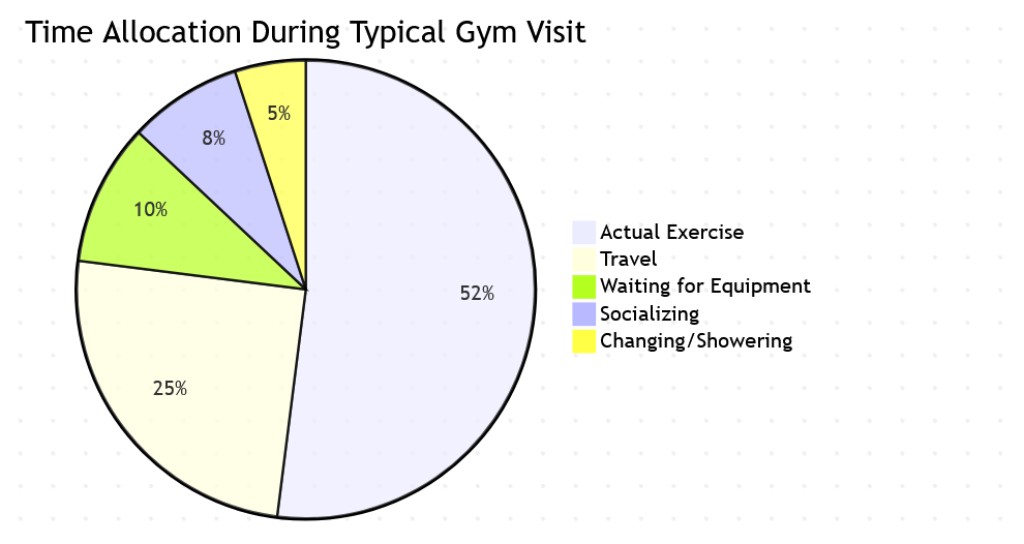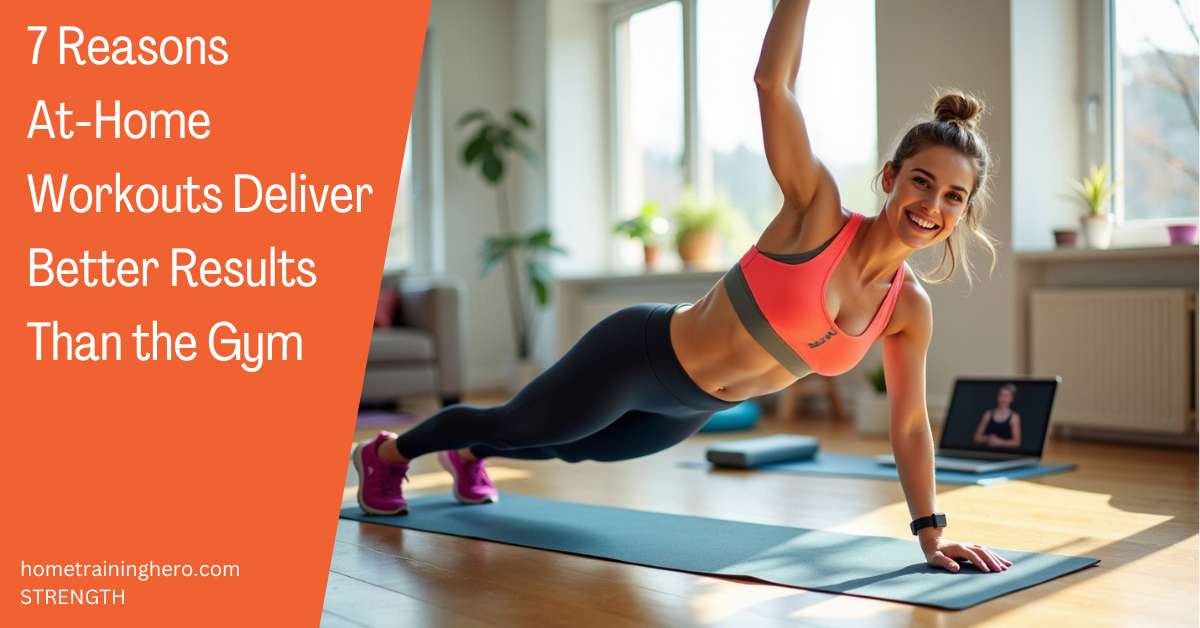Did you know that 67% of people who purchase gym memberships never actually use them? Yet these same individuals often achieve remarkable fitness results when switching to home workouts. In today’s fast-paced world, finding time to commute to a gym, wait for equipment, and deal with crowded spaces has become a significant barrier to fitness success.
Research from fitness psychology experts reveals that consistency and adherence to workout routines matter far more than fancy equipment or specialized environments. After interviewing dozens of personal trainers and analyzing the success stories of thousands of home exercisers, I’ve discovered seven compelling reasons why at-home workouts often deliver superior results compared to traditional gym settings.
In this article, I’ll break down the science-backed advantages of home training and show you exactly how to leverage these benefits for your own fitness journey. Whether you’re a busy professional, a parent juggling multiple responsibilities, or simply someone who values privacy and convenience, these insights will transform how you think about effective exercise. And if you’re ready to take your home fitness to the next level, professional guidance can make all the difference.
Contents
- 1 1. Unmatched Convenience Leads to Better Consistency
- 2 2. Personalized Environment Enhances Performance
- 3 3. Time-Efficiency Maximizes Results Per Minute
- 4 4. Customized Progressive Overload Delivers Faster Results
- 5 5. Nutritional Synergy Amplifies Workout Benefits
- 6 6. Financial Efficiency Increases Long-Term Sustainability
- 7 7. Privacy Encourages Experimentation and Growth
- 8 How to Maximize Your Home Workout Success
- 9 What About Motivation? The Home Workout Solution
- 10 FAQ About Home Workouts vs. Gym Training
- 11 Conclusion: The Home Advantage
1. Unmatched Convenience Leads to Better Consistency
Let’s be honest – one of the biggest obstacles to fitness success is simply showing up. When your gym is just a few steps away in your living room or garage, this barrier disappears completely.
Meet Sarah, a marketing executive and mother of two who struggled to maintain her gym routine for years. “I was paying $65 a month for a gym membership I used maybe twice a month,” she shares. “The 25-minute drive each way plus changing time meant I needed almost two hours free just to get a 30-minute workout.” After switching to home workouts with guidance from a qualified personal trainer, Sarah hasn’t missed a session in eight months and has lost 28 pounds.
The science supports Sarah’s experience. A study published in the Journal of Health Psychology found that proximity to exercise facilities was one of the strongest predictors of workout adherence. When your workout space is in your home, you eliminate:
- Commute time (the average American spends 26 minutes traveling to their gym)
- Waiting for equipment during peak hours
- Packing/unpacking gym bags
- Weather-related excuses
- Childcare arrangements
This convenience factor translates directly to consistency, which fitness experts universally agree is the most important factor in achieving results. As celebrity trainer Mike Matthews puts it, “The best workout routine is the one you’ll actually do consistently.”
For those looking to establish a regular routine without the hassle of gym commutes, a 3-day home workout plan can be the perfect starting point for building sustainable habits.
2. Personalized Environment Enhances Performance
The psychological impact of working out in a space you control shouldn’t be underestimated. At home, you can optimize every aspect of your environment:
- Your music, your volume: No more gym playlists or forgetting headphones
- Perfect temperature: Set the thermostat to your optimal workout temperature
- No judgment zone: Exercise without feeling watched or evaluated
- Your equipment setup: Arrange equipment exactly how you prefer it
Jason, a software developer who switched to home workouts after years of inconsistent gym attendance, discovered this benefit unexpectedly. “I always thought I needed the gym atmosphere to push myself,” he explains. “But I’ve found I actually push harder at home because I can blast my motivational playlist, wear whatever’s comfortable, and not worry about looking awkward during new exercises.”
This psychological comfort translates to measurable performance improvements. Research in sports psychology has consistently shown that environmental comfort reduces cognitive load, allowing for better focus on exercise form and intensity.
Want to maximize this psychological advantage? Expert coaches familiar with home training environments can help design workouts that specifically leverage your personal space and preferences for optimal results.
Home environments can be particularly beneficial for specific goals like building muscle. For those interested in maximizing muscle growth without traditional gym equipment, bodybuilding with resistance bands can be remarkably effective when performed in a comfortable, familiar space.
3. Time-Efficiency Maximizes Results Per Minute
In a traditional gym setting, studies show the average person spends only 52-64% of their total gym time actually exercising. The rest is spent:
- Traveling to and from the gym (average 26 minutes each way)
- Waiting for equipment (average 8-15 minutes during peak hours)
- Socializing (average 12 minutes per visit)
- Changing clothes/showering (average 15 minutes)
This inefficiency creates a significant opportunity cost. At home, a focused 30-minute workout can deliver results comparable to a 90-minute gym session simply because every minute is devoted to actual exercise.

Mark, a financial analyst who switched to home workouts after tracking his gym time, was shocked by what he discovered. “I was spending 2 hours at the gym three times weekly, but only getting about 80 minutes of actual exercise. Now I do 45-minute high-intensity home sessions four times a week and have seen better results while saving over 5 hours weekly.”
This time efficiency becomes even more valuable when utilizing methods like HIIT workouts, which research shows can deliver significant fitness benefits in sessions as short as 20 minutes.
Want to maximize your time efficiency even further? Professional trainers specializing in home workouts can design programs specifically optimized for your schedule, eliminating guesswork and wasted time.
4. Customized Progressive Overload Delivers Faster Results
Progressive overload—gradually increasing workout difficulty—is fundamental to fitness progress. At home, you can implement this principle with remarkable precision:
- Exact workout tracking: No estimating which machine you used last time
- No equipment variability: Use the same tools consistently for accurate progression
- Workout-to-workout continuity: Easier to build on previous sessions when everything is consistent
Emily, a teacher who transformed her body with home workouts, credits this precision for her success. “At the gym, if my usual equipment was taken, I’d use something similar but not identical, which made tracking progress nearly impossible,” she says. “At home, with guidance from my personal trainer, I know exactly which resistance band I used last time and can methodically increase intensity. My strength gains have been much more consistent.”
This precision allows for what exercise scientists call “microprogressions”—small, consistent improvements that compound powerfully over time. For building specific muscle groups like glutes, this targeted approach can be particularly effective, as detailed in resources like 4-week glute workout plans.
5. Nutritional Synergy Amplifies Workout Benefits
One overlooked advantage of home workouts is their natural alignment with nutrition. Consider:
- Immediate post-workout nutrition: Access your kitchen within seconds of finishing exercise
- Meal prep convenience: Work out while cooking or between meal prep steps
- Fewer unhealthy temptations: No post-gym fast food stops or vending machines
- Better hydration: Unlimited access to water during workouts
Alex, a marketing specialist who lost 35 pounds with home workouts, notes this benefit specifically: “At the gym, I’d finish exhausted and hungry, often stopping for takeout on the way home. Now I finish my workout and immediately have my prepared protein shake and healthy meal. This alone probably doubled my results.”
Nutritional timing research supports this approach. A meta-analysis published in the Journal of the International Society of Sports Nutrition found that consuming protein within 30 minutes post-exercise maximizes muscle protein synthesis—something much easier to achieve at home than when commuting from a gym.
To fully leverage this nutritional advantage, consider working with a qualified fitness professional who can provide both workout guidance and nutritional strategies tailored to your specific body type and goals.
For those looking to combine nutrition and exercise effectively, comprehensive resources like 6-week diet and workout plans can provide structured approaches that leverage this home-based advantage.
6. Financial Efficiency Increases Long-Term Sustainability
The economics of fitness significantly impact long-term adherence. Consider these averages:
- Average gym membership: $40-$70 monthly ($480-$840 annually)
- Average gym commute fuel costs: $20-$50 monthly
- Average home gym startup cost: $500-$2,000 (one-time)
- Average home workout subscription: $10-$30 monthly
| Expense Category | Traditional Gym (5-Year Cost) | Home Workout (5-Year Cost) |
|---|---|---|
| Membership/Equipment | $2,400-$4,200 | $500-$2,000 |
| Transportation | $1,200-$3,000 | $0 |
| Time Value (at $25/hr) | $7,800-$13,000 | $1,300-$2,600 |
| Total Investment | $11,400-$20,200 | $1,800-$4,600 |
This financial efficiency creates two significant advantages:
- Reduced financial pressure: No monthly payment anxiety or guilt about unused memberships
- Better equipment ROI: One-time investments in quality home equipment vs. ongoing fees
Dave, an accountant who built a home gym, calculated his break-even point: “I spent $1,800 on a comprehensive home setup with resistance bands, adjustable dumbbells, and a suspension trainer. Compared to my $65 monthly gym membership, I broke even in less than 28 months, and that’s not counting the $120 monthly value of time saved.”
This financial sustainability increases the likelihood of long-term fitness success. For those starting with minimal investment, resistance bands offer exceptional value and versatility compared to traditional weights.
Want to maximize your investment even further? A specialized home fitness coach can help you select precisely the right equipment for your goals, preventing costly purchases of items you don’t need or won’t use effectively.
7. Privacy Encourages Experimentation and Growth
Perhaps the most underrated advantage of home workouts is the psychological safety of privacy. In a survey of 1,200 fitness beginners, “fear of judgment” ranked as the #1 barrier to trying new exercises or pushing intensity limits.
At home, this barrier disappears completely, allowing for:
- Experimentation with new movements without self-consciousness
- Form practice and refinement at your own pace
- Failing safely without social anxiety
- Freedom from appearance concerns and comparison
Michael, who transformed from 270 pounds to a lean 195 through home workouts, considers this the defining factor in his success. “At 270 pounds, I was too embarrassed to try a box jump or burpee at the gym,” he shares. “At home, I could attempt, fail, rest, and try again without feeling judged. I learned exercises I’d never have tried in public.”
This psychological safety translates to faster progress through greater exercise variety and intensity. Having a knowledgeable coach guide this private learning process can accelerate results dramatically, combining the comfort of privacy with expert instruction.
For those with specific goals like core strengthening, the privacy of home allows for focused, judgment-free practice as outlined in daily core routine resources.
How to Maximize Your Home Workout Success
To leverage these advantages fully:
- Create a dedicated space, even if small (a 6×6 foot area is sufficient for most workouts)
- Invest strategically in versatile equipment like resistance bands, adjustable dumbbells, or suspension trainers
- Schedule workouts with the same commitment as any important appointment
- Follow structured programs designed specifically for home environments
- Track progress meticulously with notes, photos, or fitness apps
- Upgrade equipment progressively as fitness improves and needs evolve
Remember that effective home workouts don’t happen by accident—they require intentionality and planning. As fitness expert James Clear notes, “You do not rise to the level of your goals. You fall to the level of your systems.”
The most effective path to home workout success? Partner with a professional who specializes in home-based fitness. These experts can assess your space, equipment, and goals to design customized programs that deliver maximum results in minimum time.
What About Motivation? The Home Workout Solution
A common objection to home workouts is the perceived lack of motivational atmosphere. However, research in behavioral psychology suggests that reliance on external motivation (like gym environments) actually reduces long-term adherence compared to cultivating intrinsic motivation.
At home, you can build sustainable motivation through:
- Achievement tracking: Visible progress charts or journals
- Environmental triggers: Workout space that automatically cues exercise behavior
- Digital community: Online workout groups and accountability partners
- Reward systems: Self-designed incentives for meeting consistency goals
The ultimate motivation solution? Working with a dedicated personal trainer who combines accountability, expertise, and personalized attention to keep you consistently engaged with your fitness journey.
For those who struggle with home workout motivation, specific strategies and support systems can make all the difference. Resources on how to get motivated to work out at home provide actionable techniques for building self-sustaining motivation.
FAQ About Home Workouts vs. Gym Training
Can I build significant muscle with home workouts?
Absolutely. Research shows that muscle growth is primarily determined by mechanical tension, metabolic stress, and muscle damage—all achievable with proper home equipment like resistance bands and adjustable weights. Many bodybuilders have achieved impressive physiques training exclusively at home, especially with expert guidance on technique and programming.
What’s the minimum equipment needed for effective home workouts?
A complete beginner can start with just bodyweight exercises. For intermediate progress, a set of resistance bands, a stability ball, and adjustable dumbbells provide tremendous versatility. Advanced trainees might add a suspension trainer or specialized equipment for specific goals. A qualified home fitness coach can help you determine the exact equipment that will deliver the most value for your specific goals.
How do I prevent plateau with limited home equipment?
Progression doesn’t require more weight—it can be achieved through increased reps, decreased rest periods, slower tempos, altered angles, or combined movements. For example, moving from regular push-ups to decline push-ups creates progression without additional equipment. This is where professional expertise becomes invaluable—experienced trainers know countless ways to create progression with minimal equipment.
Are home workouts effective for weight loss?
Home workouts can be exceptionally effective for weight loss, particularly because they enable greater consistency and can be seamlessly paired with nutrition strategies. HIIT and circuit training, easily implemented at home, are among the most efficient methods for fat loss. For maximum weight loss results, consider a customized program designed by a professional who specializes in body transformation.
How do I handle motivation without the gym atmosphere?
Create environmental triggers (like laying out workout clothes the night before), implement scheduling systems, build accountability through workout partners or online communities, and track progress visually to celebrate improvements. For many people, the most effective motivation solution is working with a dedicated personal trainer who provides accountability, expertise, and personalized attention.
Conclusion: The Home Advantage
While traditional gyms certainly have their place, the evidence increasingly supports what many fitness professionals have observed: for busy adults balancing multiple life responsibilities, home workouts often deliver superior results through unmatched consistency, time efficiency, and personalized progression.
The most important factor in fitness success isn’t the environment but the consistency of execution. As the fitness adage goes, “The best workout is the one you’ll actually do.” For many, that workout happens at home, on their schedule, in their space, progressing at their pace.
Ready to experience the home training advantage for yourself? Take the next step today by connecting with a qualified personal trainer specializing in home fitness. Their expertise will eliminate guesswork, accelerate your progress, and ensure you get maximum results from every minute you invest in your health and fitness. Your ideal fitness solution isn’t across town at an expensive gym—it’s right here, a few clicks away, ready to transform your home into your personal success studio.


